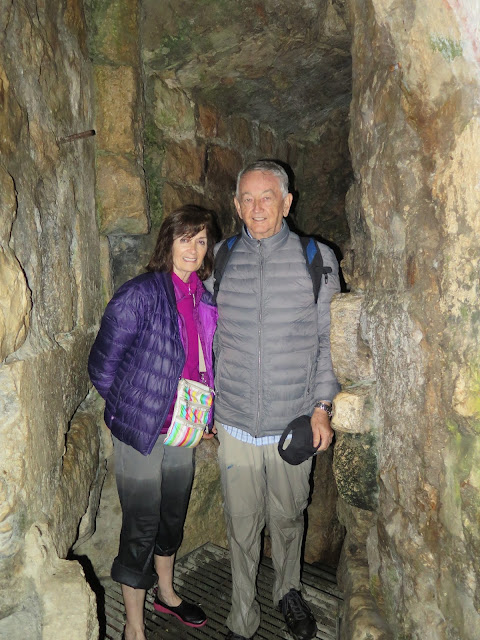Tomorrow will be a new year but today was a wonderful way to spend the last day of 2016. After church services in the Jerusalem Center auditorium, we took some photos outside before we had a quick lunch and ventured out for another day to explore the Holy Land.
It was so fun having our family with us for church services this morning.
Garth wanted to take us to the tomb of Samuel, the prophet, because there is a lovely story about Hannah, a devoted handmaid of the Lord in the Old Testament. Hannah was the mother of Samuel, the Prophet. His tomb is located in a Palestinian village at the top of a steep hill. On the site is a building containing a mosque built in the 18th century that was formerly a church. The tomb is located in an underground chamber where a small synagogue is located and where Jews and Muslims offer prayers at the tomb.
Many religious Jews visit the tomb on the anniversary of
Samuel, the Prophet's death.
Samuel, the Prophet's death.
The Tomb of Samuel and the surrounding archeological excavations are now part of a national park. An Arab village of 20 families is located on the hilltop.
According to tradition, the Crusaders found the bones of the Prophet Samuel in a Jewish cemetery in Ramla but his remains were reburied here overlooking Jerusalem. We went downstairs to where Samuel's tomb was located and found a Muslim woman in prayer. I am always fascinated with the stone structures of these buildings, particularly the arched, or dome ceilings. I am always amazed how ancient builders were able to construct them from mud, stone, concrete and glass and keep them from falling in!
We left this location and headed to the mosque at Abu Gosh. The Abu Ghosh Mosque is the second largest in Israel, only smaller than Al-Aqsa (Dome of the Rock) Mosque in Jerusalem. The construction was finished in 2014 at the cost of $10 million dollars of which $6 million was funded by the president of Russia's republic, Chechnya. An article in the Associated Press of Israel states that some residents of this area trace their ancestry to 16th century in Chechnya and for this reason the mayor of Russia's republic of Chechnya donated money for the construction of this mosque.
The mosque has four minarets which symbolize the brotherhood between religions of people. Three of the minarets symbolize the three monotheistic religions and the fourth minaret represents the rest of the world's religions. The mosque was built in the Ottoman Turkish style because that is the favored style in Russia's republic, Chechnya.
When we arrived, the mosque was just closing but we had a chance to take a quick look inside. We thought of Omer and how much he would have loved to be with us.
Our next stop would be the Garden Tomb, located just outside the Old City. The Garden Tomb is maintained as a place of Christian worship and many believe that this is the garden in which Jesus of Nazareth was buried and where He rose from the dead. When we arrived, we could hear people singing and we saw several groups of people holding religious services. It always warms my heart to hear people singing praises to God in a world that is in so much turmoil.
The Church of the Holy Sepulcher (established in the 4th century at the time of Emperor Constantine) claims to have the actual tomb of Jesus. We cannot be sure exactly where the crucifixion took place, but the exact location is of less importance than the spiritual significance of what really happened.
There are many areas in the garden where people can gather to sing and listen guides or religious leaders contemplate what tradition says happened here.
We went inside and looked at the empty tomb and paused in reverence.
The empty tomb. Note the Byzantine cross painted on the wall of the tomb.
He is not dead for He is risen.
It has been wonderful to show our family places we have visited while living in the Holy Land.
This is an ancient winepress which was excavated in 1924.
It indicates the presence of an ancient vineyard.
We left the Garden Tomb and headed to Damascus Gate at the Old City.
Adam was hungry and his mouth was watering for another falafel.
See the Falafel place at the end of the walkway . . . Adam couldn't get there fast enough.
Adam had waited all day for his favorite food in Israel and both boys devoured their falafels.
Falafel is a deep-fried ball or patty made from ground chickpeas and is a traditional Middle Eastern food commonly served in a pita (pocket bread) or wrapped in a flat bread type tortilla. The falafel balls are topped with pickled vegetables, salads, hot sauce and drizzled with a tahini type sauce. This is a very common dish and a favorite among the JC students. This particular place is located just inside Damascus Gate and has the best falafels in the Old City and the best price of just 8 shekels or about $2.00. The fritters are basically a replacement for meat and a form of street food commonly sold in Israel.
This Muslim woman sits in this same spot every day.
Muslim woman on the street.
Fresh meat?
Men will sit in front of their shops smoking these pipes.
It was getting late and we still had more places to go.
This has been one of the best days of our lives but tomorrow will bring
another adventure thanks to G'pa, our marvelous tour guide!



















































































